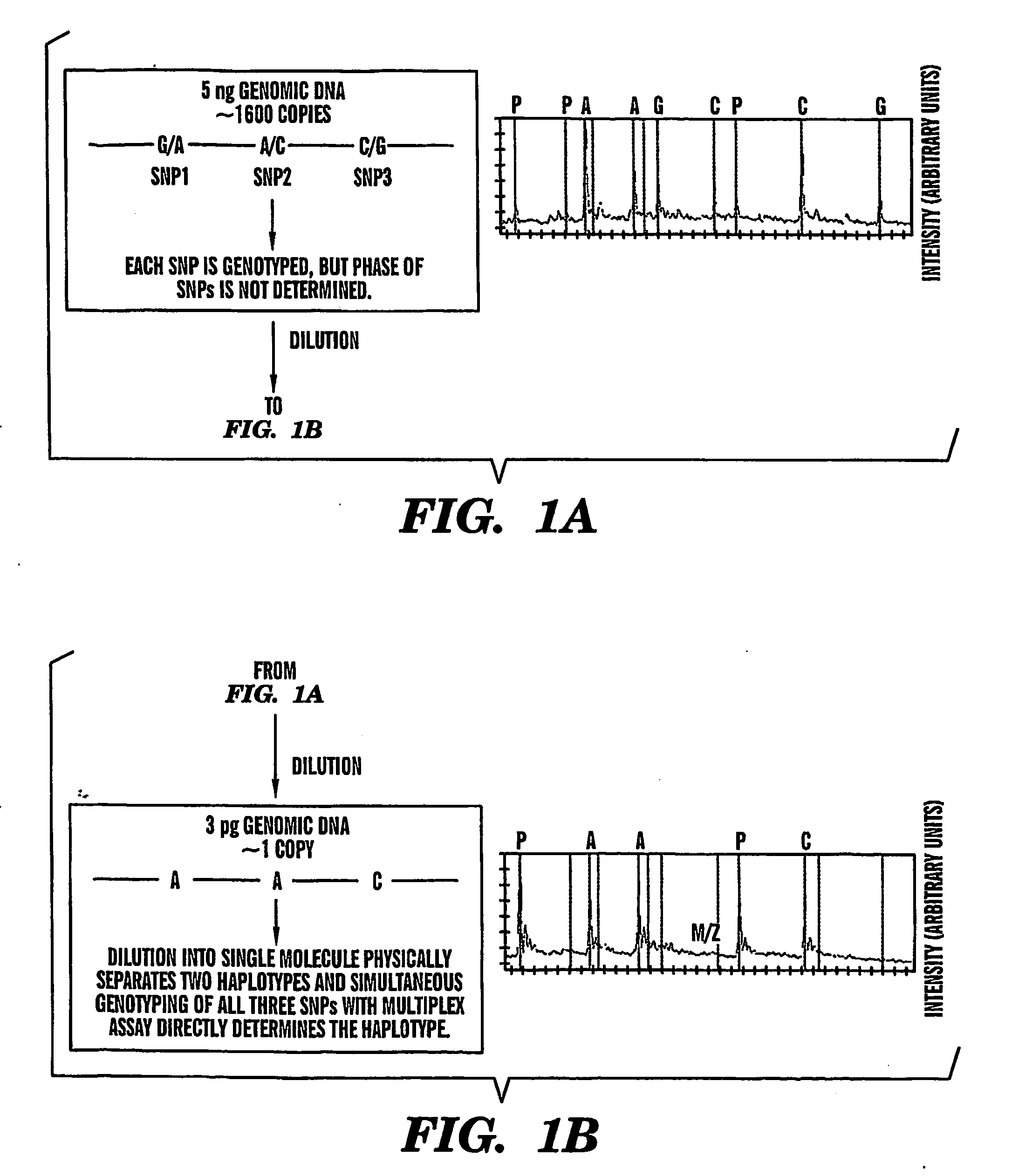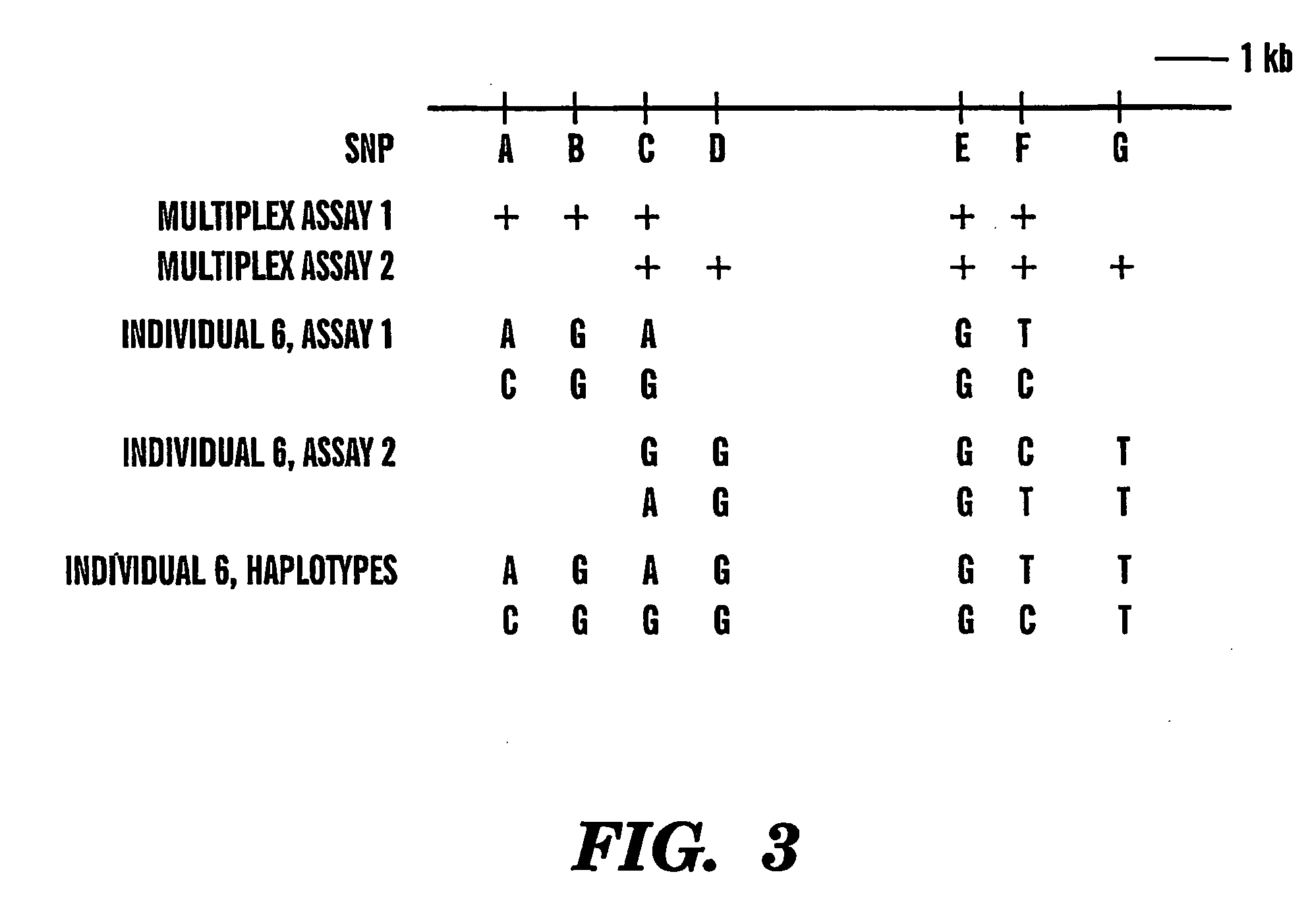[0010] The present invention provides an efficient way for high
throughput haplotype analysis. Several polymorphic
nucleic acid markers, such as SNPs, can be simultaneously and reliably determined through
multiplex PCR of single nucleic acid molecules in several parallel single molecule dilutions and the consequent
statistical analysis of the results from these parallel single molecule multiplex PCR reactions results in reliable determination of haplotypes present in the subject. The nucleic acid markers can be of any distance to each other on the
chromosome. In addition, an approach wherein overlapping DNA markers are analyzed can be used to link smaller haplotypes into larger haplotypes. Consequently, the invention provides a powerful new tool for diagnostic haplotyping and identifying novel haplotypes.
[0014] To obtain
statistical weight to accurately determine the haplotype comprising at least two markers, more than one replica of dilutions will be needed. For example, a replicate of four independent multiplex
genotyping assays using about 3-4.5 pg of human
genomic DNA, including the steps of diluting the nucleic acid sample, amplifying the diluted sample, and genotyping the amplified sample, enables about 90% of direct haplotyping efficiency. Therefore, preferably at least about 4-25, more preferably at least about 6-20, 8-20, 10-18, 12-18 and most preferably about 10-12 replicates of same sample are included in the analysis according to the present invention, one replica including the steps of diluting the isolated nucleic acid sample from a subject
organism, multiplex amplification of the diluted sample and genotyping the polymorphic nucleic acid sites from the amplified sample.
[0015] After the step of diluting the nucleic acid sample into a substantially single nucleic acid
dilution, the regions containing the polymorphic sites of interest in the nucleic acid are amplified, using, for example
polymerase chain reaction (PCR) and at least two, preferably more than two primer pairs flanking at least two different polymorphic nucleic acid sites in the target molecule. The primers are selected so that they amplify a fragment of at least about 50 base pairs (bp), more preferably at least about 100, 200, 300, 400, 500, 600-1000 bp and up to about 10000 bp, wherein the fragment contains at least one polymorphic
nucleotide site. Most preferably, the primer pairs are designed so that the amplification products are about 90-350 bp long, still more preferablyabout 100-250 bp long. It is preferable to maximize the efficiency of amplification from the single molecule template and therefore, at least with the
current technology, the shorter fragments are preferred. However, it will be self evident to a skilled artisan that the nucleic acid amplification techniques are constantly developing and the efficiency of amplifying longer nucleic acid fragments using very small quantities of template can be perfected and consequently, primers amplifying long fragments, even longer that those indicated above, may also be used according to the present invention.
[0018] The haplotype is subsequently determined by analyzing replicas of at least four
dilution / amplification / genotyping reactions so as to allow statistically accurate determination of the correct haplotype in the subject. The steps including
dilution, amplification and genotyping from the same subject
organism sample are repeated several times to obtain a
data set which can be statistically analyzed to reveal the correct haplotype in the subject
organism's sample. The approach does not rely on pedigree data and does not require prior amplification of the genomic region containing the selected markers thereby simplifying the analysis and allowing speedy and automated haplotyping.
[0022] For example, the R117H
mutation in the
cystic fibrosis transmembrane
receptor (CFTR)
gene shows mild effect without the 5T
mutation, and severe effect when the 5T
mutation is present on the same chromosome. Thus, a haplotype of R117H-5T is important for clinical application to determine the severity of the prognosis of this type of
cystic fibrosis. The method of the present invention allows direct determination of the haplotypes with no requirement for patient pedigree
genotype information, i.e. information of the genotypes from the patient's family members. The same approach can be applied in other genetic diseases where, for example, a second mutation on the same chromosome can change the
disease manifestation from the first mutation.
 Login to View More
Login to View More 


